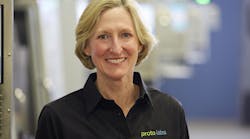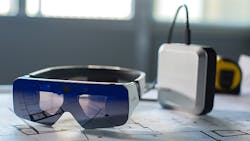Additive manufacturing is, of course, one of the major areas that will usher the industry into its next chapter of production, efficiency and, yes, public perception.
As the president and CEO of Proto Labs, a Minnesota-headquartered rapid manufacturing prototype company, Vicki Holt is a major champion for the tech. We’ve written about Holt and Proto Labs a handful of times over the last couple years, and we check in with her again to discuss the state of additive manufacturing today, some of the challenges of the tech, and a survey the company recently commissioned that might give some hope for the next generation.
IndustryWeek: Additive is increasingly important, of course, and there seem to be some key areas to focus on in 2017, including speed to market. Engineers and designers need to be able to move, they need to be able to order 3-D printing when its needed, mostly for prototype development. Where are we in that respect?
Vicki Holt: Let’s step back for a minute. Speed to market is critically important and there are lots of ways that companies can accelerate innovation. 3-D printing has really become part of the development process for many engineers and a lot of them have tackled them by purchasing 3-D printers and putting them in their operations. They’ll make you a part from your CAD and you have something in your hand. That alone accelerates innovation. We continue to see our 3-D printing grow as well for prototypes, and we’re more in the industrial kinds of processes, and that gets a part in their hands that’s a little more functional, particularly if you’re looking at an SLS or a DMLS, where you can get a part made in more of an engineered resin — a nylon part in SLS, metal parts that are fairly dense in DMLS.
IW: In terms of pace of innovation, Moore’s Law seems to be getting faster and faster. What’s new, where could we be going, and is the pace increasing at a faster rate than Moore’s Law’s recognized two years?
VH: It has gotten faster. The pace, I think it’s accelerated just in the last three to five years, with the use of different technologies, digital models like ours, the use of simulation software — all of those things are accelerating innovation. You look at some of the markets where it’s happening most often, it tends to be those markets where the world’s in a race. Let’s take robotics, drones, the world’s in a race, and the time that new things have to come to market in those spaces are much shorter. You’re looking at six months, maybe 12 months. We’ve helped some customers get products to markets from six months from the time we saw designs. It’s definitely gotten faster.
IW: What are you using to keep ahead in that race? What else is on the horizon?
VH: Right now, we’ve launched an elastomeric material in 3-D printing using a poly jet technology. That allows us to print flexible materials for our customers — we currently injection-mold flexible materials with liquid silicon rubber and a number thermal plastic urethanes and elastomeric materials, and now we’ll be able to 3-D print those, as well. We’ve launched insert molding with our digital on-demand injection-molding technology now, which is a great add.
IW: What are some of the hurdles you really want to get past?
VH: The other one is really developing quality control approaches with 3-D printing, particularly as we get pulled into production parts. We were seeing that mostly in DMLS, but we do have some SLS production parts with customers as well, and working out all of the business processes to make sure we can do quality control. Another limitation — we talked about speed to market, pace of innovation and developing quality control — is just the cost. Material costs are pretty high, the equipment itself is high especially with depreciation, and the finishing costs are high with associated labor.
Another obstacle is we need to continue to develop the skill sets of development engineers to design for 3-D printing. What that really requires is the engineer to step back and look at the final thing that they’re making and think about it from a systems point of view: If they had complete flexibility, how might they design how that would be manufactured, taking advantage of 3-D printing? That’s going to help the economics. We normally find that if a part can be made via machining or injection molding, it’s usually cheaper to do it that way than 3-D print it. However, if it’s something that literally could not be made any other way and it delivers so much value because of how it’s designed, then you can often make those economics work.
IW: Do you see a convergence point, where the cost of 3-D printing catches up to machining or injection molding and it becomes more feasible to use 3-D printing on a smaller scale?
VH: I think it may be a ways out. We have a digital model associated with injection molding and can make low-volume production with injection molding fairly cost-effective. Several companies have approached us to 3-D print tooling. We look at that, we’re open if there’s a more efficient way to do it, but we can actually take a CAD and custom-injection mold a tool cheaper than we could 3-D print it — and then you have a tool that isn’t going to wear down over time. … You probably have to look at it part by part.
IW: Shifting gears, you recently published results of a study that said 47% of American Millennials think there will be enough qualified professionals to fill manufacturing job demands in the next decade, and that 37% of American Millennials see manufacturing as a high-tech career choice — a bigger chunk that Generation Xers (27%) and Baby Boomers (23%). (The margin of error for the survey is about 3%.)
VH: We’re very interested in changing the perception of manufacturing, because we believe we’re a leader in digital manufacturing and we want to expose manufacturers to it and because we’re a growing company and we need to attract talent. As we compete for that talent, we want to the world to understand manufacturing is a high-tech business that’s changing rapidly. We commissioned this survey to help understand what our baseline is and understand what people think about manufacturing.
I was thrilled with this. The fact that 37% of Millennials think manufacturing is high tech is really refreshing. It means that younger people are being exposed to things like robotics, 3-D printing, use of digital models, big data, simulation software. The challenge is still the Baby Boomers, their parents — but they haven’t been exposed to it as much.
IW: What needs to happen get those numbers higher — Millennials thinking there will be enough qualified people for the jobs up over, say, 50 or 55%, and maybe 45% seeing manufacturing as a high-tech career choice?
VH: The innovative manufacturers — GE, Rockwell Automation, Boeing, Lockheed Martin — we all need to be out there talking about how manufacturing is changing and getting people exposure to what’s happening. We need to bring people and their parents into plants. We’re trying to change the view of manufacturing. I think Manufacturing 4.0 and digital manufacturing is the thing that’s going to create the next big productivity improvement.
Is this the real life? Is this just fantasy? / DAQRI
AUGMENTED, VIRTUAL, MIXED …: No matter what term you want to use for the tech (or what you want to use the tech for), augmented reality (or virtual reality, or mixed reality) is poised to become big business within the next decade. According to a new report from IDTechEx Research, the headset market is approaching $3.5 billion and should increase tenfold from there by 2027.
According to report authors Harry Zervos and James Hayward, “The sustained growth of the market will be propelled forward in the short term by the growth of PC VR, … and the high volume of mobile VR will not contribute significantly to total revenues due to the low unit value. From 2021 onwards, growth will be transferred to stand alone AR, propelled forward by the launch of high performing headsets and reduced power consumption that will lead to longer battery life and independence from the grid.
“Standalone VR will also make its mark, although its exact value proposition is not fully clear or even distinctly separate from standalone AR; in standalone VR, the challenge of adequate energy storage that will allow longer times between charging is magnified due to the requirements for running a high end GPU computer along with a high resolution display. In fact, both energy storage and displays for AR and VR applications are both … critical these components are for future generations of headsets.”
ROBOT OF THE WEEK: The ability to stack stones might not sound all that important. I mean, really, when would that ever be needed? But think about clearing rubble, especially after a disaster, or just the robotic ability to match shapes in an optimal order. Researchers at ETH Zurich introduced a robotic arm and camera system that can autonomously stack as many as six stones into a tower and the tech … surprisingly cool and applicable. Check out the video.
ROCKWELL ON IIOT: Rockwell Automation president and CEO Blake Moret discussed the Industrial Internet of Things last week at Cisco’s annual IoT World Forum in London. Some excerpts from the leader of the industrial automation company: “Manufacturers and industrial operators are discovering practical ways to apply IoT across their operations, and they’re deriving measurable business value as a result. Combining IoT technology and expertise in specific industrial applications enables better collaboration, faster problem-solving and increased productivity.”
CONSUMER CATCHING UP TO INDUSTRIAL: A new report from Parks Associates indicates that 45% of American broadband homes already use a voice-enabled personal assistant, and that more than 440 million connected consumer devices will be sold in the United States in 2020. (Why is so much predicted for 2020? Is it just the nice, round number? The double number? Should we just blame Roone Arledge?) This obviously includes a lot of personal assistants, like the Amazon Echo and Google Home. Those numbers obviously dwarf the industrial space, and it’s heartening to see IoT tech adopted more widely. How much better will it be — for consumer and industrial — three years from now?
COMINGS AND GOINGS: AR enterprise software company Upskill, which was recently involved with the Industry Manufacturing & Technology Conference and Expo as a tech panelist, has a new COO. Jeremy Kirsch worked previously as EVP and GM for worldwide sales for Opower (which had been acquired by Oracle), where he grew revenue from $1 million to $150 million. The company also recently Pristine, a SaaS provider and AR collaboration and video streaming software. … ABB inaugurated its new Canadian headquarters in Montreal late last month, a physical embodiment of a $90 million commitment to the country and, in turn, to North America. ABB Canada president Nathalie Pilon said the move, “allows greater collaboration with our business partners and with the academic and research sectors.”
Ah’ll be bahck. / The Rock and Roll Times
QUOTE OF THE WEEK: “No way. No way.” — Andrus Ansip, former Estonian prime minister and current European Commissioner for Digital Single Market, when asked if he supported Bill Gates’ suggested tax on robots who fill positions previously held by humans.
Gates first mentioned his robot tax during a February interview with Quartz, saying, “If a human worker does $50,000 of work in a factory, that income is taxed. If a robot comes in to do the same thing, you'd think we'd tax the robot at a similar level.” Ansip responded Thursday at a tech conference in Vienna: “I fully agree that we have to tax bad habits, for example pollution, or smoking, or drinking alcoholic drinks, this I can understand.”
Taxing robot production, though, Ansip said, seemed like “taxing progress.” Instead, Ansip is a proponent of providing skills for displaced workers. “People have a right to be afraid. I believe in progress — progress always created more jobs than progress used to destroy. We cannot stop progress. The train is moving, speed is growing and now it's up to us to be on that train or just wave to the leaving train. I think that last one is not an option for us. A lot of people will lose their jobs but our municipalities, national parliaments, the European Union and also entrepreneurs, business people need to provide skills to those people who will lose their jobs.” This is not the last we have heard about this.






